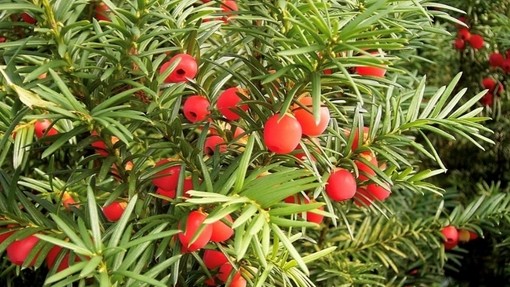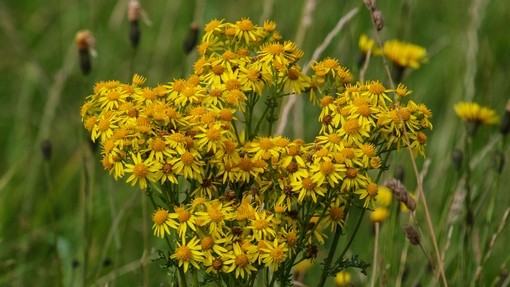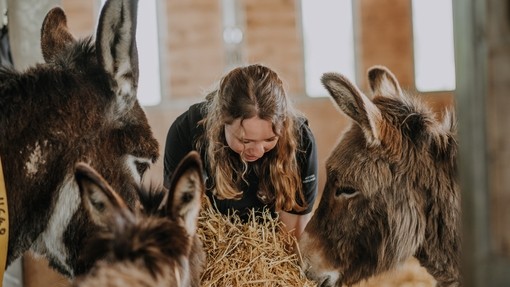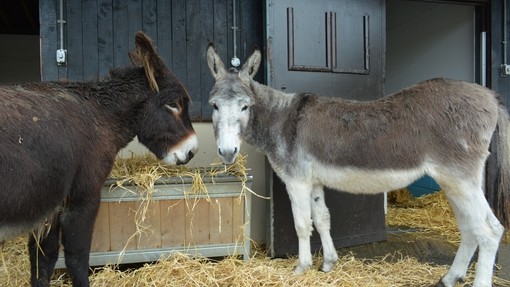Safe branches and small logs
Branches or small logs can be cut and placed (with bark and leaves on) in the enclosure. As with any new toy/boredom breaker the novelty can wear off, so branches are best removed and replaced once the donkeys have stripped them. Care should be taken when introducing anything new to your donkeys, and this is no exception. Just introduce one log to start with, giving them time to get used to it and ensure no fighting is occurring over the new branch – if there is, provide another log to avoid confrontations.
Recommended tree and shrub species:
- ash
- alder
- beech (minus beech nuts)
- birch
- blackberry
- blackthorn
- dogrose
- dogwood
- gorse
- hawthorn
- hazel
- heather
- quickthorn
- poplar
- raspberry
- sweet briar rose or rosa rugosa
- sycamore (cut logs minus leaves/flowers/seeds)
- willow (limited quantities)
Access to hedgerows or cut branches provides not only a source of food but also mental stimulation, as the donkeys indulge in a more natural style of feeding. Taking time to select, grasp and chew their food is the opposite to ‘bolting’ a meal in a bucket and means more time spent in the pleasant occupation of foraging every day!
By giving donkeys the fibre that they crave and keeping them busy for hours searching for it, we not only benefit their health by minimising inappropriate feeding but also their state of mind by keeping boredom at bay.
The forage tree
If resources allow, you may like to go one step further and consider planting donkey-friendly shrubs and trees to create hedgerow browsing areas. The concept of providing trees as a food source or ‘forage tree’ has been used with other livestock, but is fairly new to donkeys, mules, horses and ponies. More commonly, donkey owners will be familiar with the fact that their donkeys love browsing the hedgerow! Thick hedging and overhead trees can also provide a degree of shelter from the sun and wind, although due to the low levels of grease in a donkey’s coat they should never be left out in wet weather without a field shelter.
We’re not really sure what it is about browsing a hedgerow that really gets donkeys going, whether it’s the different eating heights, the choice of new shoots or woody branches, or the variety of tastes and textures.
Benefits of forage trees and shrubs:
- variety of diet
- variety of feeding heights
- provision of macro (particularly fibre) and micronutrients (dependent upon species)
- shelter from the weather
- conservation of soil
- natural habitat for wildlife
- mental stimulation
- natural feeding system
Planning and planting
Planting or re-establishing a hedgerow can take some time. Young plants will need to be protected until their roots are established, and may take up to five years to grow into a recognisable hedge. It is always advisable to plant more than is necessary as some younger plants will die or be eaten by wildlife. If you are thinking of establishing a new hedgerow, contact your local tree warden via the local council or tree council, as they will be able to advise you on suitable species for your area and may even have funding available. Autumn is generally the best time of year for undertaking this sort of project.
Faster growing shrubs such as gorse and heather may be used to plant up a corner of a paddock to provide some variation to diet and environment. Donkeys are perfectly able to browse gorse, avoiding the spiky spines and instead stripping the branches and eating the leaves and flowers.
Trees and hedgerows are a natural part of our rural landscape and home to a multitude of wildlife, including birds, small mammals and invertebrates. Hedgerows have been reintroduced over the last decade or so into our agricultural landscapes as their value in providing ‘wildlife corridors’ has been recognised. Their deep root systems, and mulch from fallen leaves, are also important in preserving the landscape and preventing soil erosion.
Poisonous plants and trees
Free choice access to hedgerows or forage trees needs to be carefully considered and all plants identified before introducing your animals to any new grazing or woodland area. If you cannot identify the species yourself using a book then we recommend contacting a specialist to be sure. Avoid allowing donkeys to consume any plant that you cannot positively identify as safe.
Sycamore seeds/seedlings, flowers and leaves have been implicated in the development of potentially fatal atypical myopathy. It is thought that the risk is greatest when there is a lack of other forage and when equids browse sycamore leaves and seeds in abundance. Providing a healthy diet with plenty of safe forage and fencing off areas susceptible to falling or blown in sycamore leaves/seeds will be key in preventing this serious disease. Please see our ‘sycamore-related atypical myopathy’ factsheet for more information.
Trees that bear berries/fruit may need to be restricted in the autumn as your donkeys are at risk of colic if they gorge themselves on an abundance of fruit. Avoid allowing donkeys access to trees of the Prunus species (plum, cherry, almond, etc) as all parts of these trees can contain varying amounts of a toxic substance and the stones may also present a choking hazard.




